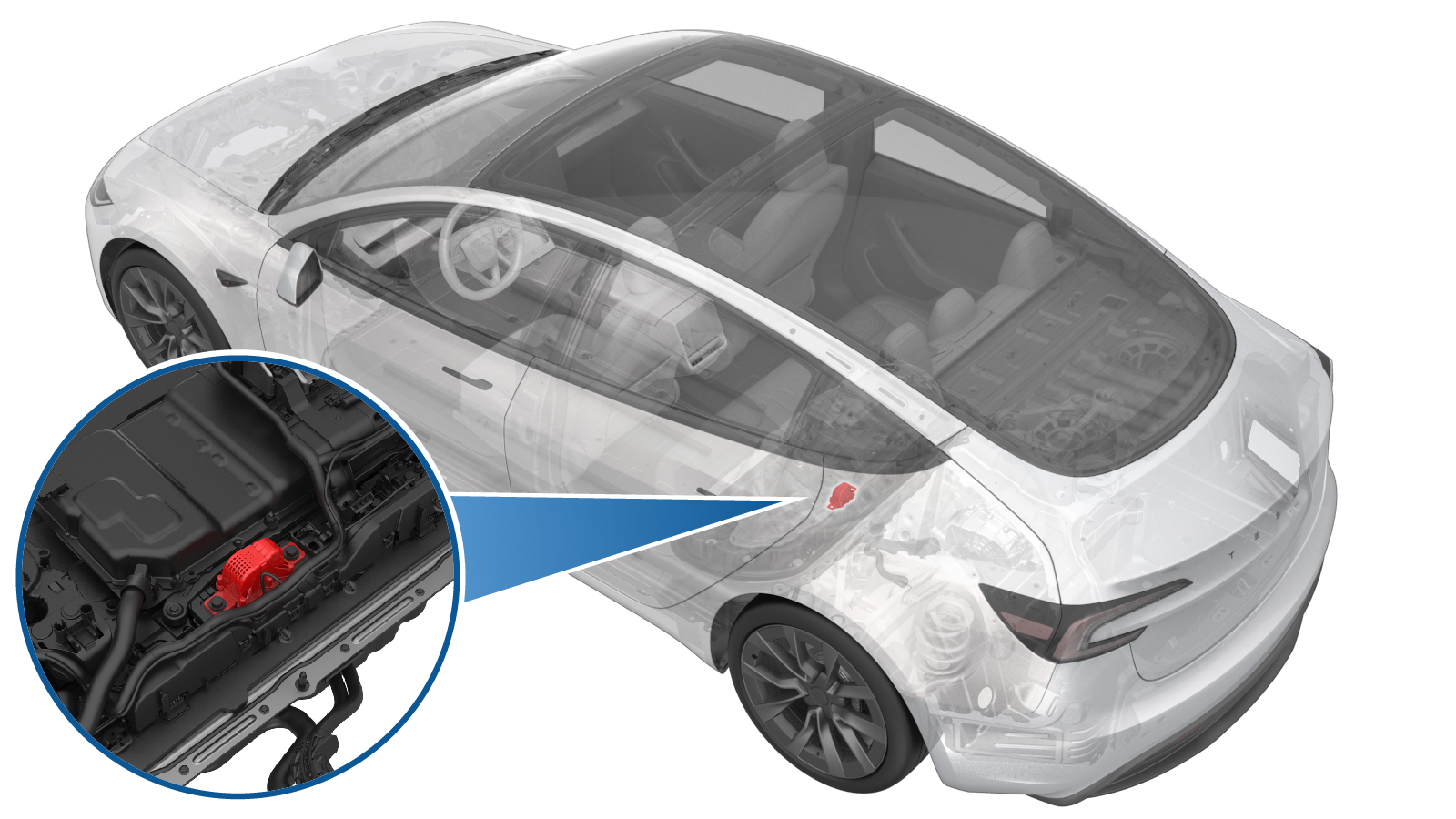Pyro Disconnect - HV Battery (Remove and Replace)
 Correction code
1630010012
FRT
0.84
NOTE: Unless
otherwise explicitly stated in the procedure, the above correction code and
FRT reflect all of the work required to perform this procedure, including
the linked procedures. Do
not stack correction codes unless explicitly told to do so.
NOTE: See Flat Rate
Times to learn more about FRTs and how
they are created. To provide feedback on FRT values, email ServiceManualFeedback@tesla.com.
NOTE: See Personal Protection
to make sure wearing proper PPE when performing the below procedure.
NOTE: See Ergonomic Precautions for safe and
healthy working practices.
Correction code
1630010012
FRT
0.84
NOTE: Unless
otherwise explicitly stated in the procedure, the above correction code and
FRT reflect all of the work required to perform this procedure, including
the linked procedures. Do
not stack correction codes unless explicitly told to do so.
NOTE: See Flat Rate
Times to learn more about FRTs and how
they are created. To provide feedback on FRT values, email ServiceManualFeedback@tesla.com.
NOTE: See Personal Protection
to make sure wearing proper PPE when performing the below procedure.
NOTE: See Ergonomic Precautions for safe and
healthy working practices.
- 1467483-00-B - M3/Y Ancillary Bay Service Insulator Kit
- 1057602-00-A Ratchet, 1/4" Sq Dr, HV Insulated
- 1057606-00-A Skt, 1/4" Sq Dr, 13mm, HV Insulated
- 1131071-00-A Dummy Disconnect, Pyro, Safety
- 1108272-00-B Cap, Logic Conn, Inv, 3DU
- 1076927-00-A Resistance meter, microohm, Hioki RM 3548
Only
technicians who have completed all required certification courses are permitted to
perform this procedure. Tesla recommends third party service provider technicians
undergo equivalent training before performing this procedure. For more information on
Tesla Technician requirements, or descriptions of the subject matter for third parties,
see HV Certification Requirements. Proper personal protective equipment (PPE) and insulating HV
gloves with a minimum rating of class 0 (1000V) must
be worn at all times a high voltage cable, busbar, or fitting is handled. Refer to Tech Note TN-15-92-003, High Voltage Awareness
Care Points
for additional safety
information.
Torque Specifications
| Description | Torque Value | Recommended Tools | Reuse/Replace | Notes |
|---|---|---|---|---|
| Bolts (x2) that attach the pyrotechnic battery disconnect to the HV battery |
 9 Nm (6.6 lbs-ft) |
|
Replace |
Remove
-
Remove the ancillary bay cover. See Ancillary Bay Cover (Remove and Replace).
WarningHV insulating gloves and leather glove protectors must be worn throughout the remainder of this procedure. Do not remove gloves or protectors until otherwise noted.
- Install the ancillary bay service insulator kit.
-
Remove the pyrotechnic
battery disconnect shunt insulator cover.
-
Remove and discard the bolts
(x2) that attach the pyrotechnic battery disconnect to the HV battery, and
then remove the pyrotechnic battery disconnect from the vehicle.
TIpUse of the following tool(s) is recommended:
- Insulated
tools:
- 13 mm socket
- Ratchet/torque wrench
- Insulated
tools:
-
Install the dummy disconnect where the pyrotechnic battery disconnect was removed.
Install
-
Perform a zero adjust of the Hioki
resistance meter in preparation to measure resistances later in this procedure. See
Resistance Meter (Zero Adjust).
WarningHV insulating gloves and leather glove protectors must be worn throughout the remainder of this procedure. Do not remove gloves or protectors until otherwise noted.
-
Remove the dummy pyro
disconnect.
- Use an IPA wipe to clean the HV mating surfaces of the shunt, busbar, and the pyrotechnic battery disconnect.
-
Set the multimeter to the
"LoZ" (low impedance) mode.
NoteFor Fluke multimeters without "LoZ" mode on the mode selector, see Multimeter (LoZ Setting).
-
Measure the voltage between the busbar (left) and shunt (right) for at
least 10 seconds, so as to balance the voltage across the pyrotechnic
battery disconnect mount points.
NoteThe voltage displayed on the multimeter is not as important as balancing the mount points.WarningThe video(s) included in this procedure are meant as an overview for supplemental purposes only. Follow all of the steps listed in the procedure to avoid damage to components and/or personal injury.
-
While still measuring the
voltage, have an assistant position the pyrotechnic battery disconnect into
the HV battery for installation. Make sure to align the pins of the
connector with the new pyrotechnic battery disconnect, and then press the
pyrotechnic battery disconnect down onto the busbars.
- Continue to measure the voltage for another 10 seconds after the pyrotechic battery disconnect has been set onto the busbars.
-
Install the new bolts (1104475-00-F
x2) that attach the pyrotechnic battery disconnect to the HV battery, and then mark the
bolts with a paint pen after they are torqued.
 9 Nm (6.6 lbs-ft)TIpUse of the following tool(s) is recommended:
9 Nm (6.6 lbs-ft)TIpUse of the following tool(s) is recommended:- Insulated
tools:
- 13 mm socket
- Ratchet/torque wrench
- Insulated
tools:
-
Use the Hioki resistance meter to
measure the resistance at the HV joint between the newly-installed pyrotechnic battery
disconnect and the module 2 busbar.
NotePreform zero adjust to Hioki meter prior to measuring.NoteThe maximum acceptable resistance is 0.060 mΩ (60 μΩ). If there is too much resistance in the High Voltage joint, remove the fastener, clean areas with isopropyl alcohol, install fastener back and test again.
-
Use the Hioki resistance meter to
measure the resistance at the HV joint between the newly-installed pyrotechnic battery
disconnect and the shunt.
NotePreform zero adjust to Hioki meter prior to measuring.NoteThe maximum acceptable resistance is 0.045 mΩ (45 μΩ). If there is too much resistance in the High Voltage joint, remove the fastener, clean areas with isopropyl alcohol, install fastener back and test again
- Remove the ancillary bay service insulator kit.
-
Install the ancillary bay cover. See Ancillary Bay Cover (Remove and Replace).
NoteBefore installing the ancillary bay cover, inspect the ancillary bay cover seal and confirm there is no visual damage. If the seal is torn and/or delaminated, replace the ancillary bay cover.